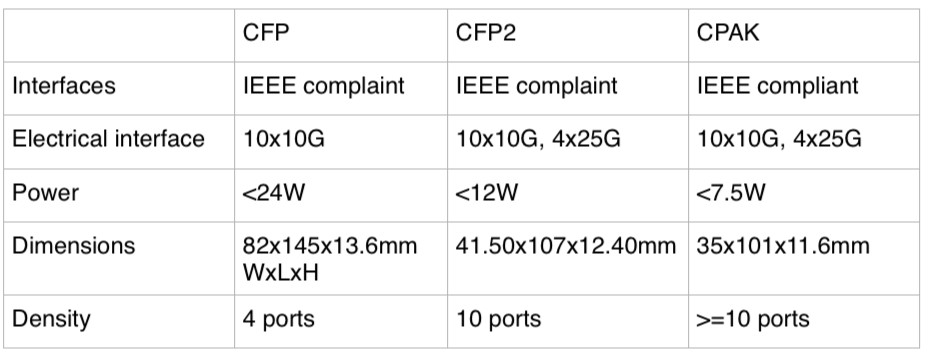Does Cisco Systems' CPAK module threaten the CFP2?
 Tuesday, October 9, 2012 at 5:45PM
Tuesday, October 9, 2012 at 5:45PM Cisco Systems has been detailing over recent months its upcoming proprietary optical module dubbed CPAK. The development promises to reduce the market opportunity for the CFP2 multi-source agreement (MSA) and has caused some disquiet in the industry.

Source: Cisco Systems, Gazettabyte, see comments
"The CFP2 has been a bit slow - the MSA has taken longer than people expected - so Cisco announcing CPAK has frightened a few people," says Paul Brooks, director for JDSU's high speed transport test portfolio.
Brooks speculates that the advent of CPAK may even cause some module makers to skip the CFP2 and go straight to the smaller CFP4 given the time lag between the two MSAs is relatively short.
The CPAK module, smaller than the CFP2 MSA and three quarters its volume, has not been officially released and Cisco will not comment on the design but in certain company presentations the CPAK is compared with the CFP. The details are shown in the table above, with the CFP2’s details added.
The CPAK is the first example of Cisco's module design capability following its acquisition of silicon photonics player, Lightwire.
The development of the module highlights how the acquisition of core technology can give an equipment maker the ability to develop proprietary interfaces that promise costs savings and differentiation. But it also raises a question mark regarding the CFP2 and the merit of MSAs when a potential leading customer of the CFP2 chooses to use its own design.
"The CFP2 has been a bit slow - the MSA has taken longer than people expected - so Cisco announcing CPAK has frightened a few people"
Paul Brooks, JDSU
Industry analysts do not believe it undermines the CFP2 MSA. “I believe there is business for the CFP2,” says Daryl Inniss, practice leader, Ovum Components. “Cisco is shooting for a solution that has some staying power. The CFP2 is too large and the power consumption too high while the CFP4 is too small and will take too long to get to market; CPAK is a great compromise.”
That said, Inniss, in a recent opinion piece entitled: Optical integration challenges component/OEM ecosystem, writes:
“Cisco’s Lightwire acquisition provides another potential attack on the traditional ecosystem. Lightwire provides unique silicon photonics based technology that can support low power consumption and high-density modules. Cisco may adopt a proprietary transceiver strategy to lower cost, decrease time to market, and build competitive barriers. It need not go through the standards process, which would enable its competitors and provide them with its technology. Cisco only needs to convince its customers that it has a robust supply chain and that it can support its product.”
Vladimir Kozlov, CEO of market research firm, LightCounting, is not surprised by the development. “Cisco could use more proprietary parts and technologies to compete with Huawei over the next decade,” he says. “From a transceiver vendor perspective, custom-made products are often more profitable than standard ones; unless Cisco will make everything in house, which is unlikely, it is not bad news.”
JDSU has just announced that its ONT-100G test set supports the CFP2 and CFP4. The equipment will also support CPAK. "We have designed a range of adaptors that allows us to interface to other optics including one very large equipment vendor's - Cisco's - own CFP2-like form factor," says Brooks.
However, Brooks still expects the industry to align on a small number of MSAs despite the advent of CPAK. "The majority view is that the CFP2 and CFP4 will address most people's needs," says Brooks. "Although there is some debate whether a QSFP2 may be more cost effective than the CFP4." The QSFP2 is the next-generation compact follow-on to the QSFP that supports the 4x25Gbps electrical interface.
 CFP2,
CFP2,  CFP4,
CFP4,  CPAK,
CPAK,  Cisco Systems,
Cisco Systems,  JDSU,
JDSU,  LightCounting,
LightCounting,  MSA,
MSA,  Ovum,
Ovum,  QSFP2+,
QSFP2+,  optical transceivers in
optical transceivers in  gazettabits
gazettabits  Print Article
Print Article 


Reader Comments (3)
The CFP2 information in the table is incorrect.
From CFP2 Baseline Specifications at:
www.cfp-msa.org/Documents/CFP_MSA_baseline_specifications_15.pdf
Interfaces: 10x10G, 4x25G
Power classes: 3W, 6W, 9W, 12W
Ports in 445mm faceplate: 10
100GE-LR4 CFP2 power using 25G DFB technology will be under 8W. The 12W highest power class enables future long reach interfaces, for example 100GE-ER4 (40km) or 100G DWDM.
Chris, thanks for the comment and the corrections. I have amended the table. And Gazettabyte has reported on the sub-8W CFP2 100GbE design using DFBs.
http://www.gazettabyte.com/home/2012/10/9/the-cfp2-pluggable-module-gains-industry-momentum.html
The key point here is that now the 100G ecosystem has a range of 100G form factors that meet all needs and expectations and can photonically inter-operate (as appropriate). The density and price roadmap that the next-generation 100G pluggables offer will now take 100G to a price competitive position. Of course CFP still is a very useful form factor (supports a wide range of applications) while CFP2/4 should get us to prime-time.